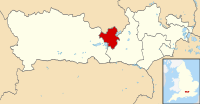Reading, Berkshire
|
Reading Borough of Reading |
||
|---|---|---|
| Town and Borough | ||

From top left: the Town Hall and St Laurence's Church, the Maiwand Lion, the Town Centre skyline from the Royal Berkshire Hospital, Reading Abbey and The Oracle
|
||
|
||
| Motto: A Deo et Regina With God and Queen |
||
 Reading shown within Berkshire |
||
| Coordinates: 51°27′15″N 0°58′23″W / 51.45417°N 0.97306°WCoordinates: 51°27′15″N 0°58′23″W / 51.45417°N 0.97306°W | ||
| Sovereign state | United Kingdom | |
| Constituent country | England | |
| Region | South East England | |
| Ceremonial county | Berkshire | |
| Historic county |
Berkshire (south of River Thames) Oxfordshire (north of River Thames) |
|
| Admin HQ | Reading | |
| Settled | 871 or earlier | |
| Town Status | 1086 or earlier | |
| Government | ||
| • Type | Unitary authorities | |
| • Governing bodies |
Reading Borough Council West Berkshire Council (suburbs) Wokingham Borough Council (suburbs) |
|
| • Mayor | Cllr Mohammed Ayub | |
| • Deputy Mayor | Cllr Rose Williams | |
| • Leader | Cllr Jo Lovelock | |
| • Deputy Leader | Cllr Tony Page | |
| Elevation | 200 ft (61 m) | |
| Population (mid-2014 est.) | ||
| • Town and Borough | 160,825 (Ranked 115th) | |
| • Density | 10,310/sq mi (3,981/km2) | |
| • Urban | 318,014 (Ranked 20th in England and Wales) | |
| • Ethnicity | 74.8% White (65.3% White British) 9.1% South Asian 6.7 % Black 3.9% Mixed Race 4.5% Chinese and Other Asian 0.9% Other |
|
| Demonym(s) | Readingensian Readingite |
|
| Time zone | GMT (UTC+0) | |
| • Summer (DST) | BST (UTC+1) | |
| Postal Code | RG1, RG2, RG4, RG5, RG6, RG7, RG30, RG31 | |
| Area code(s) | 0118 | |
| Grid Ref. | SU713733 | |
| ONS code | 00MC (ONS) E06000038 (GSS) |
|
| ISO 3166-2 | GB-RDG | |
| NUTS 3 | UKJ11 | |
| Website | reading.gov.uk | |
Reading (![]() i/ˈrɛdɪŋ/ RED-ing) is a large town in Berkshire, England, of which it is the county town. It was an important centre in the medieval period, as the site of Reading Abbey, a monastery with strong royal connections. The town was seriously affected by the English Civil War, with a major siege and loss of trade, and played a pivotal role in the Revolution of 1688, with that revolution's only significant military action fought on the streets of the town. The 19th century saw the coming of the Great Western Railway and the development of the town's brewing, baking and seed growing businesses. Today Reading is a commercial centre, with involvement in information technology and insurance, and, despite its proximity to London, has a net inward commuter flow.
i/ˈrɛdɪŋ/ RED-ing) is a large town in Berkshire, England, of which it is the county town. It was an important centre in the medieval period, as the site of Reading Abbey, a monastery with strong royal connections. The town was seriously affected by the English Civil War, with a major siege and loss of trade, and played a pivotal role in the Revolution of 1688, with that revolution's only significant military action fought on the streets of the town. The 19th century saw the coming of the Great Western Railway and the development of the town's brewing, baking and seed growing businesses. Today Reading is a commercial centre, with involvement in information technology and insurance, and, despite its proximity to London, has a net inward commuter flow.
The first evidence for Reading as a settlement dates from the 8th century. By 1525, Reading was the largest town in Berkshire, and tax returns show that Reading was the 10th largest town in England when measured by taxable wealth. By 1611, it had a population of over 5000 and had grown rich on its trade in cloth. The 18th century saw the beginning of a major iron works in the town and the growth of the brewing trade for which Reading was to become famous. During the 19th century, the town grew rapidly as a manufacturing centre. It is ranked the UK's top economic area for economic success and wellbeing, according to factors such as employment, health, income and skills. Reading is also a retail centre serving a large area of the Thames Valley, and is home to the University of Reading. Every year it hosts the Reading Festival, one of England's biggest music festivals. Sporting teams based in Reading include Reading Football Club and the London Irish rugby union team, and over 15,000 runners annually compete in the Reading Half Marathon.
...
Wikipedia

